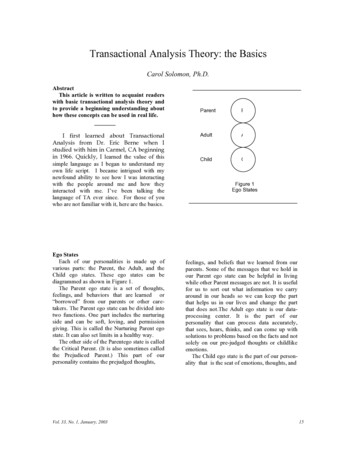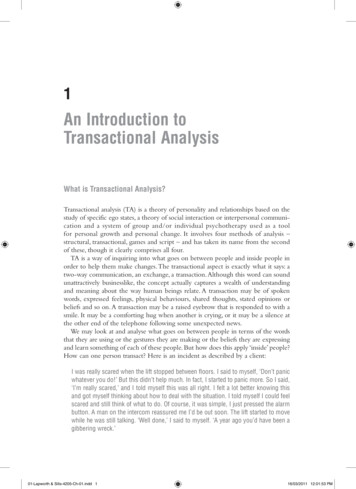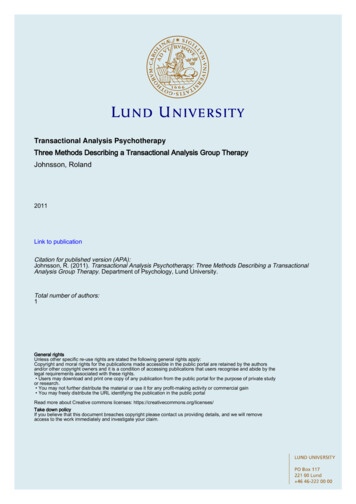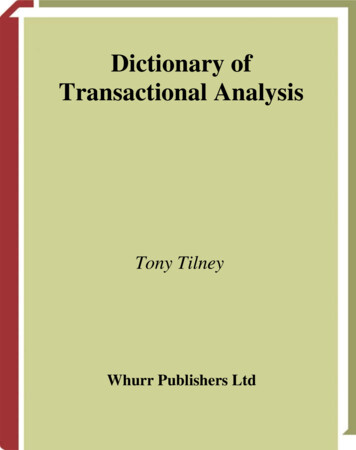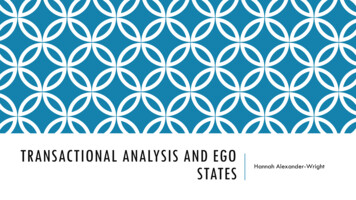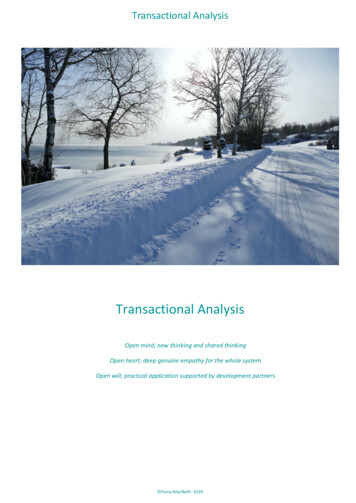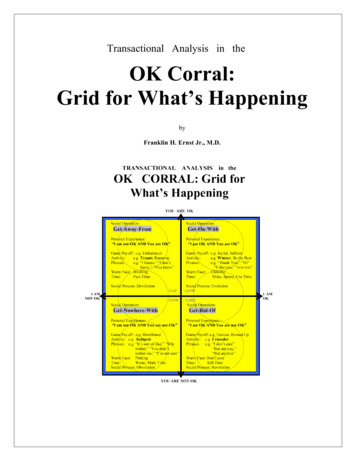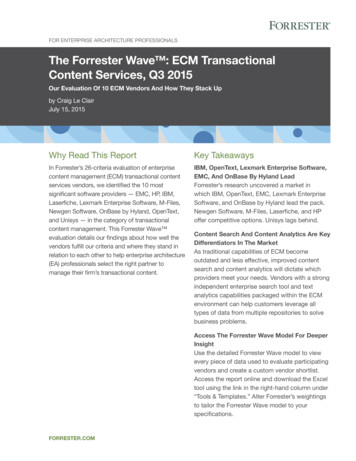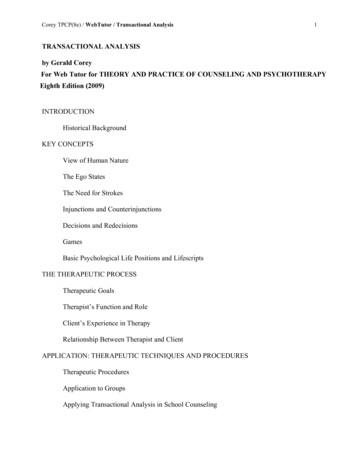
Transcription
Corey TPCP(8e) / WebTutor / Transactional Analysis1TRANSACTIONAL ANALYSISby Gerald CoreyFor Web Tutor for THEORY AND PRACTICE OF COUNSELING AND PSYCHOTHERAPYEighth Edition (2009)INTRODUCTIONHistorical BackgroundKEY CONCEPTSView of Human NatureThe Ego StatesThe Need for StrokesInjunctions and CounterinjunctionsDecisions and RedecisionsGamesBasic Psychological Life Positions and LifescriptsTHE THERAPEUTIC PROCESSTherapeutic GoalsTherapist’s Function and RoleClient’s Experience in TherapyRelationship Between Therapist and ClientAPPLICATION: THERAPEUTIC TECHNIQUES AND PROCEDURESTherapeutic ProceduresApplication to GroupsApplying Transactional Analysis in School Counseling
Corey TPCP(88e) / WebTutor / Transactional AnalysisTRANSACTIONAL ANALYSIS FROM A MULTICULTURAL PERSPECTIVEContributions to Multicultural CounselingLimitations for Multicultural CounselingSUMMARY AND EVALUATIONSummaryContributions of Transactional AnalysisLimitations and Criticisms of Transactional AnalysisEXPERIENTIAL EXERCISES AND ACTIVITIES FOR TRANSACTIONAL ANALYSISExercises for Personal Reflection and for Small GroupsQuestions for Reflection and DiscussionWHERE TO GO FROM HERERECOMMENDED SUPPLEMENTARY READINGSREFERENCES AND SUGGESTED READINGSA CASE ILLUSTRATION: A Transactional Analyst’s Perspective on Ruth, by John M. Dusay,M.D.Assessment of RuthKey IssuesTherapeutic TechniquesINTRODUCTIONTransactional analysis (TA) is both a theory of personality and an organized system ofinteractional therapy. It is grounded on the assumption that we make current decisions based onpast premises—premises that were at one time appropriate to our survival needs but that may no2
Corey TPCP(8e) / WebTutor / Transactional Analysislonger be valid. TA emphasizes the cognitive and behavioral aspects of the therapeutic process.Within TA there are three recognized schools—classical, Schiffian (or reparenting), andredecisional—and two unofficial schools identified as self-reparenting and corrective parenting.The redecisional school has gained in prominence and is the focus of this chapter.The goal of transactional analysis is autonomy, which is defined as awareness,spontaneity, and the capacity for intimacy. In achieving autonomy people have the capacity tomake new decisions (redecide), thereby empowering themselves and altering the course of theirlives. As a part of the process of TA therapy, clients learn how to recognize the three egostates—Parent, Adult, and Child—in which they function. Clients also learn how their currentbehavior is being affected by the rules they received and incorporated as children and how theycan identify the “lifescript” that is determining their actions. This approach focuses on earlydecisions that each person has made, and it stresses the capacity of clients to make new decisionsto change aspects of their lives that are no longer working.TA is set apart from most other therapeutic approaches in that it is contractual anddecisional. The contract, which is developed by the client, clearly states the goals and directionof the therapeutic process. Clients in TA establish their goals and direction and describe howthey will be different when they complete their contract. The contractual aspect of the therapyprocess tends to equalize the power of the therapist and the client. It is the responsibility ofclients to decide what they will change. To turn their desires into reality, clients are required toactively change their behavior.Historical BackgroundTransactional analysis was originally developed by the late Eric Berne (1961), who was trainedas a Freudian psychoanalyst and psychiatrist. TA evolved out of Berne’s dissatisfaction with the3
Corey TPCP(8e) / WebTutor / Transactional Analysisslowness of psychoanalysis in curing people of their problems. Berne’s major objections topsychoanalysis were that it was time consuming, complex, and poorly communicated to clients.Historically, TA developed as an extension of psychoanalysis with concepts and techniquesespecially designed for group treatment. Berne discovered that by using TA his clients weremaking significant changes in their lives. As his theory of personality evolved, Berne partedways with psychoanalysis to devote himself full time to the theory and practice of TA (Dusay,1986).Berne (1961) formulated most of the concepts of TA by paying attention to what hisclients were saying. He believed young children develop a personal plan for their life as astrategy for physical and psychological survival and that people are shaped from their first fewyears by a script that they follow during the rest of their lives. He began to see an ego stateemerge that correlated to the childhood experiences of his patients. He concluded that this Childego state was different from the “grown-up” ego state. Later he postulated that there were two“grown-up” states: one he called the Parent ego state, which seemed to be a copy of the person’sparents; the other, which was the rational part of the person, he named the Adult ego state.Four phases in the development of TA have been identified by Dusay and Dusay (1989).The first phase (1955-1962) began with Berne’s identification of the ego states (Parent, Adult,and Child), which provided a perspective from which to explain thinking, feeling, and behaving.He decided that the way to study personality was to observe here-and-now phenomena such asthe client’s voice, gestures, and vocabulary. These observable criteria provide a basis forinferring a person’s past history and for predicting future problems. The second phase (19621966) focused on transactions and “games.” It was during this period that TA became popularbecause of its straightforward vocabulary and because people could recognize their own games.4
Corey TPCP(8e) / WebTutor / Transactional AnalysisAt this time TA was primarily a cognitive approach, with little attention given to emotions. Thethird phase (1966-1970) gave attention to lifescripts and script analysis. A lifescript is aninternal plan that determines the direction of one’s life. The fourth phase (1970 to the present) ischaracterized by the incorporation of new techniques into TA practice (such as those from theencounter group movement, Gestalt therapy, and psychodrama). TA is moving toward moreactive and emotive models as a way of balancing its early emphasis on cognitive factors andinsight (Dusay & Dusay, 1989, p. 448).This chapter highlights the expansion of Berne’s approach by Mary and the late RobertGoulding (1979), leaders of the redecisional school of TA. The Gouldings differ from theclassical Bernian approach in a number of ways. They have combined TA with the principlesand techniques of Gestalt therapy, family therapy, psychodrama, and behavior therapy.The redecisional approach helps group members experience their impasse, or the point atwhich they feel stuck. They relive the context in which they made earlier decisions, some ofwhich were not functional, and they make new decisions that are functional. Redecisionaltherapy is aimed at helping people challenge themselves to discover ways in which they perceivethemselves in victimlike roles and to take charge of their lives by deciding for themselves howthey will change.KEY CONCEPTSView of Human NatureTransactional analysis is rooted in an antideterministic philosophy. It places faith in our capacityto rise above habit patterns and to select new goals and behavior. However, this does not meanthat we are free from the influences of social forces. It acknowledges that we were influenced bythe expectations and demands of significant others, especially because our early decisions were5
Corey TPCP(8e) / WebTutor / Transactional Analysismade at a time in life when we were highly dependent on others. We made certain decisions inorder to survive, both physically and psychologically, at some point in life. But these earlydecisions can be reviewed and challenged, and if they are no longer serving us, then newdecisions can be made.The Ego StatesAn ego state is a set of related thoughts, feelings, and behaviors in which part of an individual’spersonality is manifested at a given time (Stewart & Joines, 1987). All transactional analystswork with ego states, which encompass important facets of the personality and are considered tobe essential and distinguishing characteristics of TA therapy (Dusay, 1986). Each person has abasic trio of Parent, Adult, and Child (P-A-C), and individuals constantly shift from one of thesestates to another, manifesting behavior congruent with the ego state of the moment. Onedefinition of autonomy is the capacity to move with agility and intention through ego states andto operate in the one most appropriate to the reality of the given situation.The Parent ego state contains the values, morals, core beliefs, and behaviors incorporatedfrom significant authority figures, primarily one’s parents. Outwardly, this ego state is expressedtoward others in critical or nurturing behavior. We each have a “Nurturing Parent” and a“Critical Parent.” Inwardly, it is experienced as old parental messages that continue to influencethe inner Child. When we are in the Parent ego state, we react to situations as we imagine ourparents might have reacted, or we may act toward others the way our parents acted toward us.The Parent contains all the “shoulds” and “oughts” and other rules for living. When we are inthat ego state, we may act in ways that are strikingly similar to those of our parents or othersignificant people in our early life. We may use some of their very phrases, and our posture,gestures, voice, and mannerisms may replicate those that we experienced in our parents.6
Corey TPCP(8e) / WebTutor / Transactional AnalysisThe Adult ego state is the processor of data. It is the objective part of the person, whichgathers information about what is going on. It is not emotional or judgmental but works with thefacts and with external reality. The Adult is without passionate convictions, but many problemsalso require empathy and intuition to be resolved.The Child ego state is the original part of us and is most naturally who we are. It consistsof feelings, impulses, and spontaneous actions and includes “recordings” of early experiences.The Child ego state is divided into Natural Child (NC) and Adapted Child (AC), both of whichhave positive and negative aspects. The positive aspects of the Natural Child are thespontaneous, ever so lovable, loving and charming parts of all of us. The negative aspect of theNatural Child is to be impulsive to the degree our safety is compromised. The positive aspect ofthe Adapted Child is that we respond appropriately in social situations. The negative aspect ofthe Adapted Child involves overadapting wherein we give up our power and discount our value,worth, and dignity.Clients in TA therapy are first taught how to recognize in which of the ego states they arefunctioning at any given time: Nurturing Parent, Critical Parent, Adult, Nurturing Child, orAdapted Child. The aim is to enable them to decide consciously whether that state or anotherstate is most appropriate or useful.The Need for StrokesHumans need to be stimulated physically, socially, and intellectually. As we grow and develop,we need to be recognized for who we are and what we do. This need for stimulation andrecognition is referred to as “strokes”; a stroke is any act of recognition or source of stimulation.A basic premise of the TA approach is that humans need to receive both physical andpsychological “strokes” to develop a sense of trust in the world and a basis for loving7
Corey TPCP(8e) / WebTutor / Transactional Analysisthemselves. There is ample evidence that lack of physical contact can impair infant growth anddevelopment and, in extreme cases, can lead to death. Psychological strokes—verbal andnonverbal signs of acceptance and recognition—are also necessary to people as confirmations oftheir worth.Strokes can be classified as verbal or nonverbal, unconditional (being) or conditional(doing), and positive or negative. Conditional strokes say “I will like you if and when you are acertain way”; they are received for doing something. Unconditional strokes say “I am willing toaccept you for who you are and for being who you are, and we can negotiate our differences.”Positive strokes say “I like you,” and they may be expressed by warm physical touches,accepting words, appreciation, a smile, and friendly gestures. These strokes are necessary for thedevelopment of psychologically healthy people. Negative strokes say “I don’t like you,” and theytoo can be expressed both verbally and nonverbally. Interestingly, negative strokes areconsidered preferable to no strokes at all—that is, to being ignored.TA theory pays attention to how people structure their time to get strokes. It also looks atthe life plan of individuals to determine what kind of strokes they both get and give. Accordingto TA, it behooves us to become aware of the strokes we survive on, the strokes that we both askfor and receive, and the strokes that we give to others.Injunctions and CounterinjunctionsThe Gouldings’ redecision work is grounded in the TA concepts of injunctions and earlydecisions (M. Goulding, 1987). When parents are excited by a child’s behavior, the messagesgiven are often permissions. However, when parents feel threatened by a child’s behavior, themessages expressed are often injunctions, which are issued from the parents’ Child ego state.Such messages—expressions of disappointment, frustration, anxiety, and unhappiness—establish8
Corey TPCP(8e) / WebTutor / Transactional Analysisthe “don’ts” by which children learn to live. Out of their own pain, parents can issue this short,but profound list of general injunctions: “Don’t.” “Don’t be.” “Don’t be close.” “Don’t beseparate from me.” “Don’t be the sex you are.” “Don’t want.” “Don’t need.” “Don’t think.”“Don’t feel.” “Don’t grow up.” “Don’t be a child.” “Don’t succee
Transactional analysis (TA) is both a theory of personality and an organized system of interactional therapy. It is grounded on the assumption that we make current decisions based on past premises—premises that were at one time appropriate to our survival needs but that may no . Corey TPCP(8e) / WebTutor / Transactional Analysis 3 longer be valid. TA emphasizes the cognitive and

